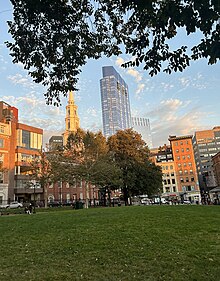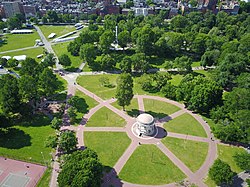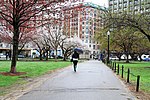|
Boston Common
The Boston Common is a public park in downtown Boston, Massachusetts. It is the oldest city park in the United States.[4] Boston Common consists of 50 acres (20 ha) of land bounded by five major Boston streets: Tremont Street, Park Street, Beacon Street, Charles Street, and Boylston Street. The Common is part of the Emerald Necklace of parks and parkways that extend from the Common south to Franklin Park in Jamaica Plain, Roxbury, and Dorchester. The visitors' center for the city of Boston is located on the Tremont Street side of the park. The Central Burying Ground is on the Boylston Street side of Boston Common and contains the graves of artist Gilbert Stuart and composer William Billings. Also buried there are Samuel Sprague and his son Charles Sprague, one of America's earliest poets. Samuel Sprague was a participant in the Boston Tea Party and fought in the Revolutionary War. The Common was designated as a Boston Landmark by the Boston Landmarks Commission in 1977.[5] The Common is sometimes erroneously referred to as the "Boston Commons".[6][7] HistoryEarly history  William Blaxton was the first European owner of the land. He arrived in the Massachusetts Bay Colony as chaplain to the Robert Gorges expedition that landed in Weymouth in 1623. Every other member of this colonization attempt returned to England before the winter of 1625. Blaxton migrated five miles north to the Shawmut Peninsula, then a rocky bulge at the end of a swampy isthmus surrounded on all sides by mudflats. Blaxton lived entirely alone for five years on the peninsula that became Boston.[8] In 1630, Blaxton wrote a decisive letter to the Puritan group led by Isaac Johnson, whose colony of Charlestown was then failing from lack of fresh water. Blaxton advertised the excellent natural springs of the peninsula and invited Johnson's group to settle with him on it, which they did on September 7, 1630. Johnson died less than three weeks later and Blaxton negotiated a grant of 50 acres around his home on the western edge of the peninsula from Governor John Winthrop. This amounted to approximately 10 percent of the available land on the Shawmut Peninsula and stretched from Beacon Hill to Boylston Street.[9] One of Johnson's last official acts as the leader of the Charleston community was to name the new settlement across the river Boston after his original home in Lincolnshire, England. He had immigrated to Massachusetts Bay Colony with his wife Arbella and John Cotton, grandfather of Cotton Mather, during the Puritan Migration. However, Blaxton quickly tired of his Puritan neighbors and the difficulty of retaining such a large plot of land in a town that had grown to nearly 4,000 people by 1633. This led him to sell all but six of his 50 acres back to Winthrop in 1634 for £30 ($5,455 adjusted). The governor purchased the land through a one-time tax on residents amounting to 6 shillings (around $50 adjusted) per person. Those 44 acres became the town commons of Boston and today form the bulk of Boston Common.[9] During the 1630s, the Common was used by many families as a cow pasture. This traditional use for a commons quickly ended when the large herds kept by affluent families led to overgrazing and the collapse of the Common as pastureland.[10] In 1646, grazing was limited to 70 cows at a time. The Common continued to host cows until they were formally banned in 1830 by Mayor Harrison Gray Otis.[11][12] The Granary Burying Ground located at the southern edge of the Common was established in 1660. Two years later, part of this land was separated from the Common, with the southwest portion used for public buildings—including a granary and jail—and the north portion dedicated to an almshouse (probably the first in the Thirteen Colonies).[13][14][15] Boston Common took over from the gibbet outside the gate of Boston Neck as the town execution grounds and was used for public hangings until 1817. Most of these executions were carried out from the limb of a large oak, which was replaced with a gallows in 1769. Those executed included common criminals, military deserters, Indians, captured pirates, and religious dissidents. The most famous victims of the Common's era as an execution grounds were the group of Quakers known almost immediately after their deaths as the Boston Martyrs. The most famous of the Boston Martyrs was executed on June 1, 1660. This was Mary Dyer, who was hanged from the oak by the Puritan government of Boston for repeatedly defying a law that banned Quakers from the Massachusetts Bay Colony.[16][17][18][8]  The Common's status as a civic property led to its use as a public speaking grounds, frequently used by evangelists such as George Whitefield. On May 19, 1713, 200 citizens rioted on the Common in the Boston Bread Riot in reaction to a serious food shortage in the city. They later attacked the ships and warehouses of wealthy merchant Andrew Belcher who was exporting grain to the British West Indies for higher profits. The lieutenant governor was shot during the riot.[19][20] The Common was used as a military camp by the British before the American Revolutionary War, and it was from the Common that they set off for the Battle of Lexington and Concord.   Firework displays over Boston Common began as early as July 3, 1745 in celebration of the fall of Louisburg, followed by the celebration of the repeal of the Stamp Act on May 19, 1766 and the first anniversary of the signing of the Declaration of Independence on July 4, 1777. True park status seems to have emerged no later than 1830, when the grazing of cows was ended and renaming the Common as Washington Park was proposed. Renaming the bordering Sentry Street to Park Place (later called Park Street) in 1804[21] already acknowledged the reality. By 1836, an ornamental iron fence fully enclosed the Common and its five perimeter malls or recreational promenade. Tremont Mall was an imitation of St. James's Park in London and had been in place since 1728. Park developmentBoston Street Scene (Boston Common), Edward Mitchell Bannister, a depiction of the street and Boston Common area in 1898–99 Execution of Ann Hibbins on Boston Common, on charges of witchcraft, June 19, 1656. Sketch by F.T. Merril, 1886 The Common was used for a variety of purposes until its formal conversion into a public park during the 1830s. These uses gradually became more urban as the city developed, shifting from pastureland to military drilling field, execution grounds, public gathering place, and finally parkland. The park was originally "out of bounds" for Blacks and Indians, a restriction that was fought by the Black community in Boston until it was lifted on July 4, 1836.[22] The Charles Street side of Boston Common and the adjacent portions of the Public Garden were initially used as an unofficial dumping ground due to being in the lowest-lying portions of the two parks. This resulted in the portions of the two parks being "a moist stew that reeked and that was a mess to walk over" and driving visitors away from these areas, but the cost of repair prevented the work from being undertaken. This finally changed in the summer of 1895, when the required quantity of soil was made available as a result of the excavation of the Tremont Street subway which was used to regrade the Charles Street sides of Boston Common and the Public Garden.[23] Recent history and designationA hundred people gathered on the Common in early 1965 to protest the Vietnam War. A second protest happened on October 15, 1969, this time with 100,000 people protesting in the Moratorium to End the War in Vietnam.[24][25] Boston Common was added to the National Register of Historic Places in 1972 along with the adjacent Boston Public Garden. The Common was declared a National Historic Landmark in 1987 with its own listing on the National Register.[1][3] It is managed by the Boston Park Department and cared for by Friends of the Public Garden, a private advocacy group which also provides additional funding for maintenance and special events.[26] Notable features The Boston Common Frog Pond sits at the heart of the Common and is managed by the Skating Club of Boston in partnership with the City of Boston.[27] Frog Pond is home to a winter ice skating rink and learn-to-skate school, a reflecting pool in the spring and fall, and a summer spray pool and children's carousel. The softball fields lie in the southwest corner of the Common. A grassy area forms the western part of the park and is most commonly used for the park's largest events. A parking garage lies under this part of the Common. A granite slab there commemorates Pope John Paul II's October 1, 1979 visit to Boston. The Pope said mass that day to an estimated 400,000 people.[28] In 1913 and 1986, prehistoric sites were discovered on the Common indicating American Indian presence long before it was colonized.[29] Since 1971, the Province of Nova Scotia has donated the annual Christmas Tree to the City of Boston as an enduring thank-you for the relief efforts of the Boston Red Cross and the Massachusetts Public Safety Committee following the Halifax Explosion of 1917.[30] Both the Common and Public Garden have been developed for recreational and aesthetic purposes: while the Common is primarily unstructured open space that facilitate social and political gatherings, the Public Garden providing a more manicured landscape for promenading.  Structures
Neighboring structures
Notable recurring events
See also
References
Further reading
External linksWikimedia Commons has media related to Boston Common.
|
||||||||||||||||||||||||||||||||||

















